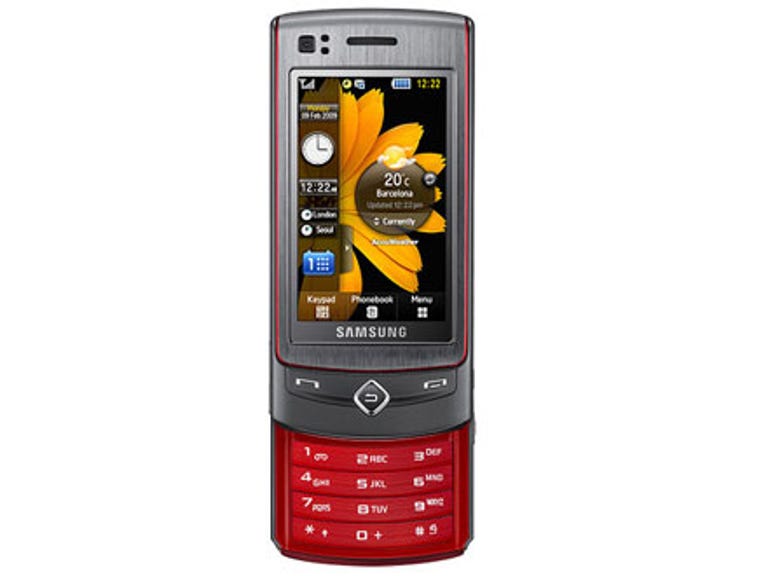 Why You Can Trust CNET
Why You Can Trust CNET Samsung UltraTouch (S8300) review: Samsung UltraTouch (S8300)
Its camera is great and the screen looks amazing, but the UltraTouch is not a knockout. It's a weird mix of business looks, average apps and dodgy performance, and we just can't tell who exactly Samsung is trying to sell it to.
Design
Though UltraTouch sounds like a beauty product, a foot spa perhaps, the handset design is unmistakably masculine. The metal chassis on our review unit is mostly a chocolaty grey with metallic rose trimming, and combined with its sharply rounded corners and angular mechanical keys, the UltraTouch is the mobile phone equivalent of a power suit, the kind you'd wear to a board meeting to intimidate your competition.
The Good
The Bad
The Bottom Line
The most startling aspect of this phone, however, is the AMOLED display. Active Matrix Organic Light Emitting Diode is part of the OLED family of technologies we've seen emerge in televisions recently, and without going into details about how it works and how it's different, you can believe us when we say it looks sensational. Blacks are deep and bold, while colours appear rich. One of the main advantages to using AMOLED displays is that the screen is viewable from almost any angle, so you don't need to hold the phone right in front of your face to see it clearly.
At 12.9mm the UltraTouch is only millimetres thicker than the slimmest touchscreens in market at this time, though it has what most don't: a numeric keypad hidden under a sliding mechanism. This gives you the choice to type your messages with real buttons or by using the on-screen virtual keyboard. The slider mechanism is brilliant, it moves smoothly to open and close and doesn't rattle loosely at all. Opening the slider also reveals the 8-megapixel camera and its LED photolight flash as well.
In line with the agreements made by many of the major phone labels at this year's MWC showcase in Barcelona, the UltraTouch charges using a micro-USB input rather than the standard Samsung proprietary port. This agreement will see most new phones use the USB input as standard and will eliminate not being able to find the right charger for your phone model.
Features
Most of what makes this phone exciting is due to its design; the screen, camera and controls. Under the hood is a standard range of top-end phone hardware including HSDPA and Wi-Fi. In Australia there will be two variations on the dual-band 3G radios, one featuring 900/2100MHz compatibility and an 850MHz version for Telstra customers. It also features a GPS receiver, but the review unit we've seen doesn't include a dedicated navigation software, only Google Maps for location searches.

For our money, the real showstopper is the 8-megapixel camera. The lens is protected by the phone's slider and is assisted by an LED photolight in low-light environments. The flash is quite a cold light, and is really useful only over short distances, but is handy nonetheless. Scanning the camera's digital settings you'll find four focus modes; a bunch of white balance presets; the ability to set the flash to on, off or auto; plus anti-shake technology and blink detection. The camera also has a video mode which shoots moving pictures at 30 frames per second in VGA image resolution, making for some very decent YouTube videos.
The UltraTouch features a decent media player with support for DivX, MPEG4 and WMV video files, plus a range of audio files including MP3, AAC and WMA. The music player interface is easy to use, and the large screen real estate means you can change settings like the equalisation preset without leaving the "now playing" screen. Strangely, all our tracks listed in alphabetically order on the phone, and we couldn't find anything in the settings to list the tracks in the order they appear on their respective albums.
The video player couldn't be simpler to use, which automatically goes into full-screen mode when you turn the phone on the side. Videos in a variety of formats look fantastic on the AMOLED display. While there's no 3.5mm headphone socket on the UltraTouch, Samsung has chucked an adapter in the box with a pair of very decent headphones as well. The adapter also doubles as the FM radio antenna for dialling into your favourite radio analog station.
Performance
Interface lag is one of the major peeves at CNET, and the UltraTouch lags just enough to annoy us. The touchscreen is very responsive, as in the software selects what you are trying to select, but the phone always feels like it's one step behind. You open the contacts menu, it pauses to load it, you drag the widgets menu up or down and the display stutters while it processes. In some ways you feel like the phone is controlling your movements rather than you controlling it.
Lag aside, we had no trouble using the UltraTouch. All the menus are clearly labelled and basic phone features work as expected. The calls we made and received during testing were loud and clear. The on-screen keyboard to create messages is fine, though without directional navigation keys we've found it difficult to correct some mistakes made when typing them up. Battery life is fine, though not extraordinary. When we used the phone predominantly for calls and messages it lasted for between two to three days, though it is possible to drain the battery in a day with a few hours of web browsing and media playback.
Overall
The UltraTouch is a phone that has grown on us during the testing period, but is far from one of our favourite phones. The touchscreen is responsive but the interface lags, and though there's no size compromise for having the keypad, the cramped keypad on the UltraTouch doesn't inspire use. The UltraTouch will get lost in the mix a bit: it's not a smartphone, but it costs as much as one; it looks like a business phone, but it lacks the business usability; plus it's not an excellent touchscreen, which it really needs to be because there's not much else for it to hang its hat on. The AMOLED display is superb and watching videos would be great if you weren't forced to use the bulky headphone adapter in the micro-USB port.
The camera is the standout, and the UltraTouch is probably our favourite Samsung 8-megapixel camera phone to date, compared solely at this stage to the bulky INNOV8 (the INNOV8 has a better range of smartphone features). This said, if we were in the market for a touchscreen 8MP camera phone, we'd buy an LG Renoir. If you break the world up into segments of phone users, the UltraTouch feels like a phone that belongs to no group at all.


